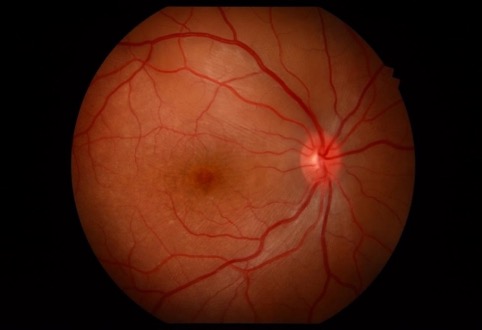A Case Report: Recurrence of Vogt-Koyanagi-Harada Disease after Rapid Tapering of Corticosteroids
DOI:
https://doi.org/10.38179/ijcr.v1i1.5Keywords:
Vogt-Koyanagi-Harada Disease, VKHD, case report, recurrence, uveitisAbstract
Background: Vogt-Koyanagi-Harada's disease (VKHD) is an autoimmune disorder that targets melanocyte-rich tissues in genetically susceptible individuals. It can affect the eyes, inner ears, skin, hair, and meninges. When VKHD affects the eye, it can cause bilateral granulomatous panuveitis with exudative bullous retinal detachment and is usually associated with meningismus. It may lead to permanent loss of visual acuity. While the pathogenesis remains unknown, viral infection has been implicated. The most accepted theory remains a T-cell mediated autoimmune reaction against one or more antigens associated with melanocytes, melanin, and retinal pigment epithelium (RPE).
Case presentation: We report the case of a 17-year-old male patient presenting to our outpatient department for vision loss. The patient reported a 2-week history of hearing loss, tinnitus, and episodic headaches associated with vomiting. Physical examination showed white lashes (poliosis) and a bilateral decrease in visual acuity. Fluorescein angiography showed bullous exudative retinal detachments. The patient was diagnosed with VKHD. His symptoms resolved following a course of oral prednisolone that was initiated at 60 mg per day (1mg/Kg/day), then tapered down over 6 weeks. Six months later, the patient presented again with more pronounced symptoms. His Best Corrected Visual Acuity (BCVA) was lower than it was on his first presentation, and the retinal exam showed a sunset glow fundus and degenerative changes in the RPE. Combined therapy with prednisolone and methotrexate resulted in a complete resolution of symptoms, and his BCVA returned to more than 20/40.
Conclusion: This case emphasizes the importance of avoiding the rapid tapering of corticosteroids in VKHD due to the high risk of disease recurrence.
References
Salmon, John F. "Uveitis." Kanski's Clinical Ophthalmology. 9th ed. Philadelphia, PA: Elsevier (2020): 423-84. Print.
Rajendram, Ranjan, Monica Evans, and Narsing A. Rao. "Vogt-Koyanagi-Harada disease." Int Ophthalmol Clin 45.2 (2005): 115-134.https://doi.org/10.1097/01.iio.0000155904.87679.0c
García, Lourdes Arellanes, Mónica Orozco Carroll, and Manuel Alejandro Garza León. "Vogt-Koyanagi-Harada syndrome in childhood." International ophthalmology clinics 48.3 (2008): 107-117. https://doi.org/10.1097/IIO.0b013e31817d9b70
Mota, Luiz Alberto Alves, and Arthur Borges Dos Santos. "Vogt-Koyanagi-Harada syndrome and its multisystemic effects." Rev Assoc Med Bras 56.5 (2010): 590-5. https://doi.org/10.1590/S0104-42302010000500023
Andreoli, Christopher M., and C. Stephen Foster. "Vogt-Koyanagi-Harada disease." Int Ophthalmol Clin 46.2 (2006): 111-122. https://doi.org/10.1097/00004397-200604620-00011
Lavezzo, Marcelo Mendes, et al. "Vogt-Koyanagi-Harada disease: review of a rare autoimmune disease targeting antigens of melanocytes." Orphanet J Rare Dis 11.1 (2016): 29. https://doi.org/10.1186/s13023-016-0412-4
Nashtaei, Ebrahim M., et al. "Patterns of uveitis in the Middle East and Europe." J Ophthalmic Vis Res 6.4 (2011): 233.
Hamade, Issam H., et al. "Uveitis survey in children." Br J Ophthalmol 93.5 (2009): 569-572. https://doi.org/10.1136/bjo.2008.148015
Baltmr, Abeir, Sue Lightman, and Oren Tomkins-Netzer. "Vogt-Koyanagi-Harada syndrome-current perspectives." Clin Ophthalmol 10 (2016): 2345. https://doi.org/10.2147/OPTH.S94866
Patil, Yojana B., et al. "Vogt-Koyanagi-Harada (VKH) syndrome: A new perspective for healthcare professionals." J Family Med Prim Care 9.1 (2020): 31. https://doi.org/10.4103/jfmpc.jfmpc_787_19
Rao, Narsing A., et al. "Frequency of distinguishing clinical features in Vogt-Koyanagi-Harada disease." Ophthalmology 117.3 (2010): 591-599. https://doi.org/10.1016/j.ophtha.2009.08.030
Lai, T. Y. Y., et al. "Effects of the duration of initial oral corticosteroid treatment on the recurrence of inflammation in Vogt-Koyanagi-Harada disease." Eye 23.3 (2009): 543-548. https://doi.org/10.1038/eye.2008.89
Alan, Irmak Sayın, and Bahadır Alan. "Side Effects of Glucocorticoids." Pharmacokinetics and Adverse Effects of Drugs-Mechanisms and Risks Factors (2018). https://doi.org/10.5772/intechopen.72019
Herbort Jr, Carl P., et al. "Reappraisal of the management of Vogt-Koyanagi-Harada disease: sunset glow fundus is no more a fatality." Int Ophthalmol 37.6 (2017): 1383-1395. https://doi.org/10.1007/s10792-016-0395-0
Wu, Lihteh, et al. "Intravitreal bevacizumab for choroidal neovascularization secondary to Vogt-Koyanagi-Harada syndrome." Jpn J Ophthalmol 53.1 (2009): 57-60. https://doi.org/10.1007/s10384-008-0600-4
Sugiura, Seiji. "Vogt-Koyanagi-Harada disease." (1978).
Bouchenaki, Nadia, and Carl P. Herbort. "The contribution of indocyanine green angiography to the appraisal and management of Vogt-Koyanagi-Harada disease." Ophthalmology 108.1 (2001): 54-64. https://doi.org/10.1016/S0161-6420(00)00428-0

Published
How to Cite
Issue
Section
Copyright (c) 2020 International Journal of Clinical Research

This work is licensed under a Creative Commons Attribution-NonCommercial-ShareAlike 4.0 International License.







